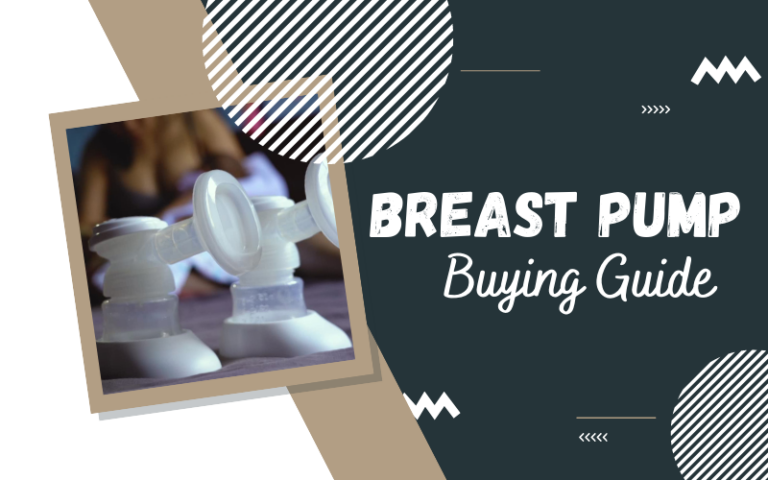One of the benefits of modern technology is that for every situation, a host of alternatives have become available.
When there is a diverse range of devices available, each with its own strong features, choosing a device that would really be the best fit for one’s situation, becomes a difficult task!
So it is with breast pumps.
There is a wide range of breast pumps available, each suitable for specific situations that mothers find themselves in.
A lot of research has gone into making breast pumps as effective as possible, and there are many manufacturers with a rich catalog of breast pump products and accessories.
The principle behind this rich variety is essentially the same.
Suction requires power. And this power could be manual, or it could come from a battery or a regular electric supply.
The amount of suction determines the stimulation that the breasts will receive. This suction has to be optimal.
A higher suction can cause injury to the tender breast tissues, while lower suction will not be able to express milk that is engorged in the breasts.
The cycle of suction-to-release and relax-to-suction requires controlling.
In battery-operated and electricity-driven pumps this cycle is controlled automatically. But in manual pumps, the cycle is controlled by the mother herself.
Finally, the frequency of cycles; that is, the number of such cycles per minute that the pump works; is a determinant of its quality.
How to Choose a Breast Pump Like a Pro
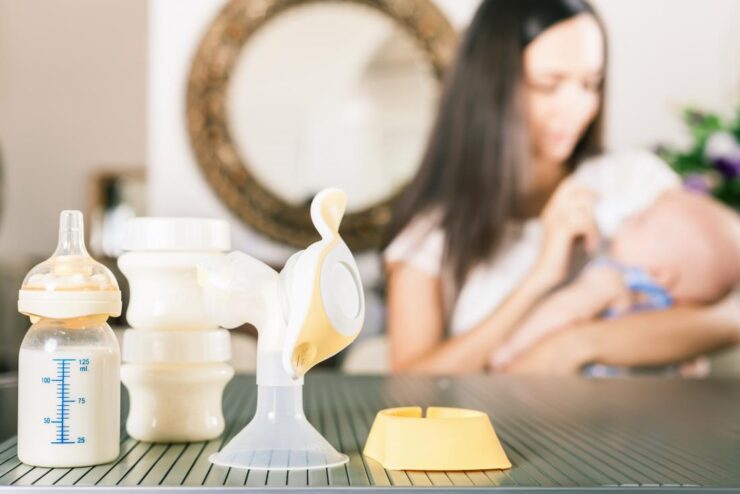
Of all these breast pumps, which one should you choose?
Which amongst these various breast pumps should one choose, would depend on many factors:
- The age of the child.
- The number of pumping sessions that one plans to do every day.
- Whether one intends to travel along with the breast pump, and so on.
All the breastpumps available in the market have some of the other strong points that fit in with your typical situation, and also have some of the other weak points that do not.
Manual Breast Pumps
Manual breast pumps have to be operated by hand. There is either a trigger or a cylinder or a pedal pump, that regulates the cycle.
These pumps are quite ideal when there are no electric outlets in the vicinity.
Available at low costs, the pumps are useful when the expression has to be carried out only occasionally, perhaps a planned outing for a mom who stays at home most of the time.
The speed at which milk is expressed from such pumps is slower than the other varieties, and a time of about half-an-hour may be budgeted for each breast.
Electric Breast Pumps
If the child’s condition is such that nursing at the breast is not possible at all, then a high-quality pump is called for.
Such a pump might ideally be a dual pump that pumps both the breasts simultaneously and is electrically-operated.
There are a few models that come with the convenience of setting the cycle levels, too, and the mother can adjust it to the comfort level that best suits her.
These pumps are more expensive but are worth the investment.
For the Budget-Conscious Mom
For the budget-conscious, a less expensive alternative might be single-breast pumps, that express from one breast at a time.
Again, they come with electric-supply and battery attachments.
These are equally effective. Only now it takes double the time to complete one session of pumping.
Which amongst the two should be chosen – single or dual – will depend on:
- The cost.
- The time available with the mom for this work, and…
- The frequency of expressing every day.
The higher the frequency, the more time will be required, and the more a dual pump becomes attractive.
Portability
The light-weightedness and portability of the breast pump is another factor to consider.
If the device is to be carried to the workplace every day, the more compact it is, the better.
The accessories that come along with each device also need to be looked into. Some accessories might be indispensable for you; while others might be of no use to the mom at all.
Breastpump is a worthwhile investment.
When one compares feeding one’s child with a breast pump – expressed milk against industrial-formula milk, the former wins hands-down, anytime.
The joy of nourishing your baby with your own milk can be realized with a breast pump – only, first, learn how to choose.
Hi-tech Breastpumps For the Hi-tech Mom!
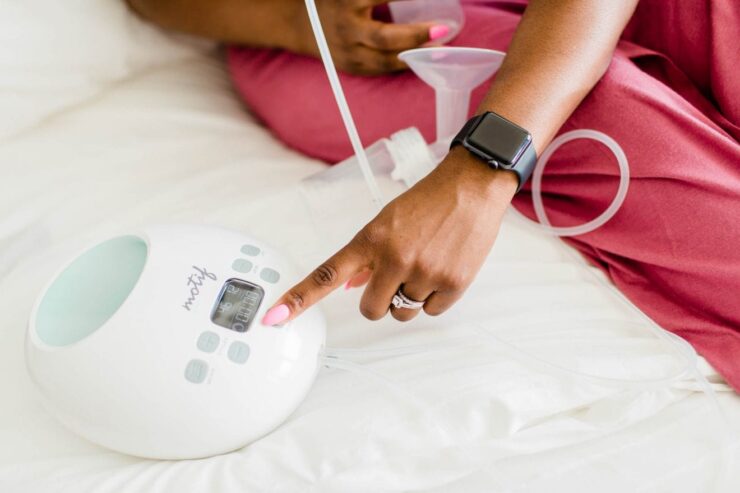
Mothers of an earlier era would not recognize their modern-day avatars.
The mother of today is a confident lady, thanks to the heavy support of benevolent technology available with her.
Years of studies and research have taken away the pain and the discomfort that once used to be associated with the very natural phenomenon of childbirth and rearing.
When social conditions reached the stage when females started working alongside the males in offices and factories.
They were not taken seriously for a long-haul career, simply because”infant-rearing is on the way”.
Many a promising female professional has had to either give up her job/vocation in order to look after her newly-born child.
At best, she would have to hang her boots at least for the first year or two, till the child could be weaned away from breastfeeding.
Introduction of the Breast Pump
Science noticed this problem, and the breast pump was born.
With a rudimentary device, mothers could express milk while they were away from their children. They can then store it in clean hygienic containers, and feed it to their child after returning home.
As mothers have become more and more techno-savvy and demanding about what they need and want.
It was but natural for science, technology, and the market to follow suit.
Today, all three are busy dancing to the tunes of the hi-tech mom, trying to please her with newer and newer gizmos with greater comfort.
1. The Medela Symphony Breast Pump


Take the Medela Symphony breast pump for instance. Looking at this equipment, one would marvel at the heights that man would conquer in order to indulge in simple pleasures.
No exaggeration in this.
Simply look for the computer chip that is embedded in the equipment that provides a feature called a Program Card, which can store “pumping programs!”
Its advanced motor design allows for super-quiet operation and an array of sleek controls that a modern mom would be quite at home with.
Imagine a deserted location where a mother has accidentally forgotten her breast pump equipment behind (she wouldn’t, for her life, but let’s visualize she has).
If a UFO were to land at this spot and pick up the equipment, it would be doubtful if their R&D engineers would ever figure out what all those fancy knobs and the computer chip were meant for!
2. Medela Purely Yours Breast Pump
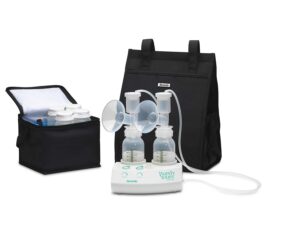

Another hi-tech machine is the Purely Yours breast pump.
This machine has up to eight (!) adjustable suction levels and four (!) cycle speeds. This, the mother can alter at will, in order to maximize her comfort level.
Weighing only one pound, and operable through either an AC adapter, AA batteries, or a car adapter, it is surely a winner amongst the breastfeeding community.
There are numerous instances when the mother just can’t spare the time, and her hands, to simply set aside and begin expressing milk.
Well, there is a “hands-free” breast pump available for such super-busy moms too!
3. Medela Freestyle Breast Pump


This device will enable a mom to cup her breasts with the milk collectors and connects them with a container where the milk is accumulated.
The device can be operated through batteries and has buttons that control the level of suction as well as the speed of operation.
Unless somebody is watching very closely, people do not even get to know that you are expressing milk at that very moment.
Not only the pump, but even the accessories have undergone dramatic advancements that make the life of today’s mom easier.
Older generations rue that they did not have such facilities at their time!
Experiences in Breastpumping
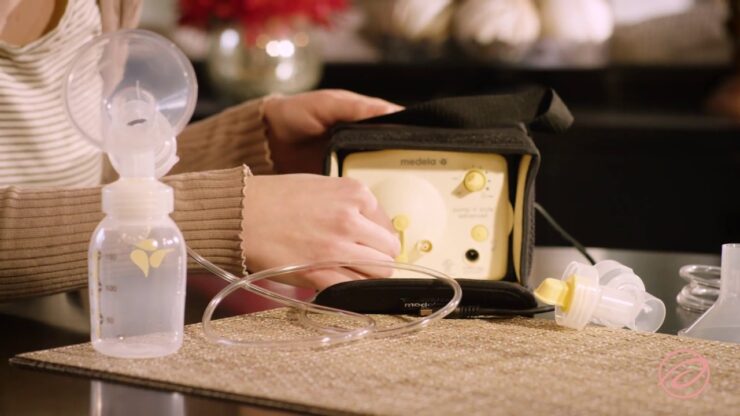
Although a mother begins to prepare herself mentally for all that she will be going through post-partum.
When she actually reaches the stage, there are hordes of quite interesting experiences that await her.
Long used to briskly walking down the steps, a minibag or an executive briefcase in hand, she now finds herself straddled with attractive, albeit “slightly” heavy, carry bags… that have the breast pump and all its sturdy components neatly concealed inside it – that brisk walk automatically slows down a wee bit!
For the first time mom, giving her child milk from her breasts is the best she could offer.
This very thought is both unnerving and thrilling to her.
The first few days are most crucial when both the child and the mother are trying to understand each other.
And also exploring the best position and the best technique for the child to latch on to the breast is a major exercise.
A few mothers discover that the child is experiencing difficulty in nursing – maybe there is some jaw problem that only the doctor would be best able to diagnose.
Or the mother is not able to lactate at just the right time. In such cases, recourse to a suitable breast pump is the best option available.
When It’s Time to Go Back to Work
The breast pump, otherwise, enters the scene when the mother returns to work.
Here, the distance between the place of work and home, availability of a second person, maybe an at-home spouse or a caregiver, who can feed the child on time, all make a difference.
For some mothers, it is possible to arrange such that the spouse or the caregiver bring the baby to them during lunch hour, so direct nursing can occur.
A few others can drive down to the child’s daycare center to nurse their precious one.
For others not so fortunate, expressing milk into sterilized bags, to be carried home later, is the only option.
In all these cases, mothers who love chatting with colleagues during that precious hour miss their hobby very much!
Breast Pumping in Public

Breast pumping in public is the biggest mental block that all mothers have to face. The problem is compounded if it is double-pumping equipment.
Mothers usually employ a lot of creativity in finding places where pumping can be done discreetly.
Those who have their own cabins conjure a neat tag that is hung from the outer doorknob. And the whole office knows better than to knock, as long as the tag is there.
A slight signal, or simply “knowing” that someone is watching, is enough for the body to react strongly, and the milk flow to stop.
It takes a while to overcome this consciousness and carry on regardless.
Renting a Breast Pump
Searching for that electric-outlet is another challenging exercise that mothers indulge in when the pump they are carrying is not manual – most of the time it is not – and the batteries are running low.
Now, if the mother is required to travel outdoors, maybe to attend a conference or a meeting with the clients or suppliers, the situation becomes tricky.
In quite a few buildings, the bathrooms do not have electrical outlets.
A creative mother then requests the people she is visiting to show a place on their premises, where her pumping work can be carried out in privacy.
Of course, if she encounters females there, they will understand. Or if the organization has a lactation program in place where a separate room is provided for breastfeeding mothers, she should count her lucky stars!
Mastering the Routine
Gradually, the routine of pumping, go to work, pump again, come back, nurse, sleep, pump again, tends to grow on the mother to such an extent, that life seems to be nothing, but pumping or nursing the child.
You know you have had it up to your eyes when images of nursing and pumping start running in the dreams!
It is somewhere around that time, that the baby starts breastfeeding less often, and begins enjoying other foods.
Breast Pumping Tips
Breast pumps come in a variety of styles. A Breast pump must be safe, effective and comfortable. Always read the manufacturer’s instructions before using your pump.
A healthy infant is far more effective at emptying the breast than any pump. Remember, breastfeeding is a learned process.
Be patient, it may take several tries before you are comfortable and proficient. Here are some basic tips to boost your breast pumping ability.
- Always wash your hands before breast pumping.
- Use deep breathing techniques to relax and assist with let-down
- Apply warm compresses to your breasts before breast pumping.
- Move the pump’s breast shield around to stimulate more milk ducts.
- If let-down is difficult, have a drink of water, juice or tea before or during pumping.
Your ideal pumping time will depend on your baby’s schedule. If you wish to prepare a bottle, try pumping in the morning after feeding when milk is most plentiful.
To maintain an adequate milk supply, frequent feeding or pumping is necessary. Milk supply may diminish over time, especially if the baby is not breastfeeding regularly.
When you begin to breastfeed again, the milk supply will increase.
How to choose a breast pump
Finally, remember to take good care of yourself! Eat a balanced diet, drink plenty of fluids and get lots of rest.
Breastfeeding a baby doesn’t mean you should starve. In fact, it’s during this time you should take care of yourself most.
We trust you’ll do exactly that. And that’s what really matters!

